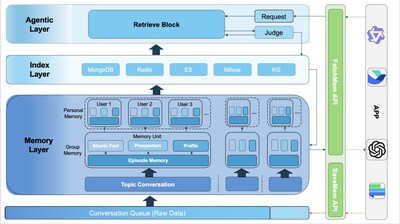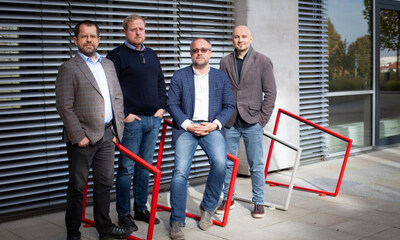$1.3 Billion Augmented and Virtual Reality (AR VR) Market in Aviation, 2025 by Technology (AR, VR), Function (Training, Operations), Component (Hardware, Software), Application (On-Board, Off-Board)
Press Releases
Nov 01, 2019
DUBLIN, Nov. 1, 2019 /PRNewswire/ — The “Augmented and Virtual Reality (AR VR) Market in Aviation by Technology (AR, VR), Function (Training, Operations), Component (Hardware, Software), Application (On-Board, Off-Board), Product, Vertical, and Region – Global Forecast to 2025” report has been added to ResearchAndMarkets.com’s offering.

The augmented and virtual reality market in aviation is projected to grow from USD 78 million in 2019 to USD 1,372 million by 2025, at a CAGR of 61.2% during the forecast period.
AR VR in aviation enables smoother and efficient operations that lead to cost savings in aviation functions such as manufacturing, maintenance, airport operations, airline operations, aviation training, among others. AR VR provides an immersive and interactive approach that connects the aviation ecosystem to improve the efficiency of various tasks. Smoother airport and airline operations lead to more revenue as aircraft spend less time out of service and more time flying.
Augmented reality (AR) technology permits computer-generated data or imagery to overlay physical objects accurately in real-time. AR enhances the perception of users, and the provided information helps them perform tasks in the real world. The major components of an AR system are displays, sensors, and embedded electronics. It is widely used in areas such as employee training and video conferencing.
Virtual reality (VR) technology provides the user with a virtual environment using computer hardware and software. It provides a fully immersive environment in which the user can interact with objects similar to those in the real world. VR technology works on components such as gesture recognition systems, sensors, and embedded electronics.
Improved passenger experience, reduced chances of human error, and increased demand for higher efficiency and cost savings in aviation have led to an increase in the demand for AR VR technology in aviation.
Apart from a general overview of the major companies in this market, this report also provides financial analyses and information about the products, services, and key developments of major players in the industry. Microsoft Corporation (US), Google Inc. (US), Eon Reality (US), Aero Glass (US), and Upskill (US), are some of the leading players covered in this report. The report also provides competitive leadership mapping for the market.
Key Topics Covered:
1 Introduction
2 Research Methodology
3 Executive Summary
4 Premium Insights
4.1 AR VR Market in Aviation, 2019-2025
4.2 AR VR Market in Aviation, By Function
4.3 AR VR Market in Aviation, By Technology
4.4 AR VR Market in Aviation, By Country
5 Market Overview
5.1 Introduction
5.2 Market Dynamics
5.2.1 Drivers
5.2.1.1 Increased Demand for Higher Efficiency and Cost Saving in Aviation
5.2.1.2 Reduced Chances of Human Error
5.2.1.3 Improved Passenger Experience
5.2.2 Restraints
5.2.2.1 Privacy Concerns Regarding Personal Data
5.2.2.2 Associated Health Risks
5.2.3 Opportunities
5.2.3.1 Integration of Artificial Intelligence (AI) and Machine Learning (ML) With AR VR
5.2.4 Challenges
5.2.4.1 Technology Limitations
5.2.4.2 Cyber Security Issues
6 Industry Trends
6.1 Introduction
6.2 Digital Reality
6.2.1 Augmented Reality (AR) Technology Trends
6.2.1.1 360-Degree View for Pilots
6.2.1.2 3D Aircraft Inspection and Maintenance
6.2.1.3 Enhanced Aviation Manufacturing
6.2.2 Virtual Reality (VR) Technology Trends
6.2.2.1 Immersive Training
6.2.2.2 Passenger Experience
6.2.3 Mixed Reality (MR) Technology Trends
6.2.3.1 MR Approach Towards MRO
6.2.3.2 Mr in Aviation Training and Manufacturing
6.2.4 Futuristic Trend: Wearable Cockpits
6.3 Innovation & Patent Registrations
7 Augmented Reality and Virtual Reality Market in Aviation, By Technology
7.1 Introduction
7.2 Augmented Reality
7.2.1 Marker-Based
7.2.1.1 Low Memory and Processing Capacity Requirements
7.2.1.2 Passive Markers
7.2.1.3 Active Markers
7.2.2 Non-Marker-Based
7.2.2.1 Real-Time and More Interactive Augmentation
7.2.2.2 Model-Based Tracking
7.2.2.3 Image-Based Tracking
7.3 Virtual Reality
7.3.1 Immersive
7.3.1.1 Enhanced User Experience
7.3.1.2 Semi-Immersive
7.3.1.3 Fully Immersive
7.3.2 Non-Immersive
7.3.2.1 Low-Cost Solutions and Technical Ease
8 Augmented Reality and Virtual Reality Market in Aviation, By Function
8.1 Introduction
8.2 Training
8.2.1 Pilots
8.2.1.1 Immersive Simulator Training Essential for Pilots
8.2.2 Crew & Ground Support Staff
8.2.2.1 Well-Trained Crew & Ground Staff Ensures Smooth Functioning of Airlines
8.2.3 Engineers
8.2.3.1 Reduced Human Error Drives the Demand for AR VR Training for Engineers
8.3 Operations
8.3.1 Airlines
8.3.1.1 Need to Reduce Airline Operating Costs Drives the Demand for AR VR
8.3.2 MRO
8.3.2.1 Quick MRO Turnaround Time Drives the Use of AR VR Technology
8.3.3 Airports
8.3.3.1 Increased Need for Connected and Smart Airports Drives the Demand for AR VR Technology
8.3.4 Aircraft
8.3.4.1 Demand for VR-Based In-Flight Entertainment Drives Its Market
8.3.5 OEMs
8.3.5.1 Optimizing Aviation Manufacturing and Design Made Possible With AR VR
9 Augmented Reality and Virtual Reality Market in Aviation, By Product
9.1 Introduction
9.2 Head-Mounted Displays
9.2.1 Easy Real-Time Access to Information and Increased Field of View for Pilots
9.3 Head-Up Displays
9.3.1 Assists Pilots With Navigational Information During Take-Off and Landing
9.4 Handheld Devices
9.4.1 Improved Efficiency of Cabin Crew Training Drives the Market
9.5 Gesture-Tracking Devices
9.5.1 Used as A Medium to Interact and Navigate in the Virtual World
10 Augmented Reality and Virtual Reality Market in Aviation, By Component
10.1 Introduction
10.2 Hardware
10.2.1 Sensors
10.2.1.1 Accurate Input of Physical Environment Helps Track A User’s Position
10.2.2 Processors & Controllers
10.2.2.1 Need for Better Computing Power Drives the Market
10.2.3 Displays
10.2.3.1 Demand for Next-Generation Miniature Displays Drives the Market
10.2.4 Cameras
10.2.4.1 Use of 3D Cameras Aids Growth of the AR VR Market
10.2.5 Others
10.3 Software
10.3.1 Augmented Reality
10.3.1.1 Widely Used in Crew Training Programs
10.3.2 Virtual Reality
10.3.2.1 Increasing Use of Simulators in Training Programs Drives the Market
11 Augmented Reality and Virtual Reality Market in Aviation, By Application
11.1 Introduction
11.2 On-Board
11.2.1 In-Flight Entertainment
11.2.1.1 Need to Upgrade Passenger Experience is Accelerating the Use of VR Devices in Aviation
11.2.2 Flight Deck Systems
11.2.2.1 Trend of Automated Pilot Assistance to Drive the Demand for AR VR in Cockpits
11.3 Off-Board
11.3.1 Increasing Efficiency and Cost Savings are Possible Using AR VR Technology
12 Augmented Reality and Virtual Reality Market in Aviation, By Vertical
12.1 Introduction
12.2 Civil
12.3 Military
13 Regional Analysis
13.1 Introduction
13.2 North America
13.2.1 US
13.2.1.1 Presence of Key AR VR Players is Driving Demand in the US
13.2.2 Canada
13.2.2.1 High Projected Demand is Expected to Drive the Market
13.3 Europe
13.3.1 France
13.3.1.1 Partnerships Between Aircraft OEMs and AR VR Players Driving the Market
13.3.2 UK
13.3.2.1 High Passenger Traffic Driving the Need for Operational Efficiency Via AR VR Technology at Airports
13.3.3 Germany
13.3.3.1 Partnerships Between Airlines and AR VR Players Driving the Market
13.3.4 Rest of Europe
13.3.4.1 Military Fighter Procurement and Presence of Major Airports Driving the Demand for AR VR Technology
13.4 Asia Pacific
13.4.1 China
13.4.1.1 Large Aircraft Fleet and Military Spending Driving the Demand
13.4.2 India
13.4.2.1 New Airport Projects Driving the Demand for Off-Board AR VR Technology
13.4.3 Japan
13.4.3.1 Strong Capabilities in Electronics Driving the Market
13.4.4 Singapore
13.4.4.1 AR VR in MRO Training and Operations Driving the Market
13.4.5 Rest of Asia Pacific
13.4.5.1 AR VR Demand is Driven By Passenger Traffic Due to Increased Tourism
13.5 Rest of the World
13.5.1 Latin America
13.5.1.1 Presence of Aircraft OEMs Driving the Market
13.5.2 Middle East
13.5.2.1 Airlines & MRO Training and Operations Driving the Demand
13.5.3 Africa
13.5.3.1 Growth in Passenger Traffic Driving the Market
14 Competitive Landscape
14.1 Introduction
14.2 Competitive Analysis
14.2.1 AR VR Market in Aviation Competitive Leadership Mapping (Overall Market)
14.3 Competitive Scenario
15 Company Profiles
15.1 Microsoft Corporation
15.2 Google Inc.
15.3 Eon Reality
15.4 Aero Glass
15.5 Upskill
15.6 Sita
15.7 HTC
15.8 Bohemia Interactive Simulations
15.9 Oculus VR
15.10 Skylights Aero
15.11 Magic Leap
15.12 PTC Inc
15.13 Fountx
15.14 Future Visual
15.15 Jasoren
15.16 Atheer Air
15.17 Elbit Systems
15.18 Honey Well
15.19 Sony
15.20 IBM
For more information about this report visit https://www.researchandmarkets.com/r/s33kwj
Research and Markets also offers Custom Research services providing focused, comprehensive and tailored research.
Media Contact:
Research and Markets
Laura Wood, Senior Manager
[email protected]
For E.S.T Office Hours Call +1-917-300-0470
For U.S./CAN Toll Free Call +1-800-526-8630
For GMT Office Hours Call +353-1-416-8900
U.S. Fax: 646-607-1907
Fax (outside U.S.): +353-1-481-1716
SOURCE Research and Markets



